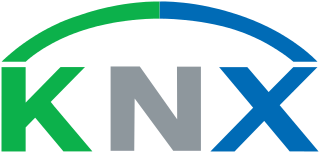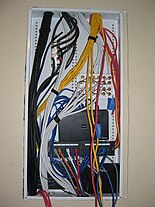Related Research Articles

Parallel ATA (PATA), originally AT Attachment, also known as IDE, is a standard interface designed for IBM PC-compatible computers. It was first developed by Western Digital and Compaq in 1986 for compatible hard drives and CD or DVD drives. The connection is used for storage devices such as hard disk drives, floppy disk drives, and optical disc drives in computers.

Small Computer System Interface is a set of standards for physically connecting and transferring data between computers and peripheral devices. The SCSI standards define commands, protocols, electrical, optical and logical interfaces. The SCSI standard defines command sets for specific peripheral device types; the presence of "unknown" as one of these types means that in theory it can be used as an interface to almost any device, but the standard is highly pragmatic and addressed toward commercial requirements. The initial Parallel SCSI was most commonly used for hard disk drives and tape drives, but it can connect a wide range of other devices, including scanners and CD drives, although not all controllers can handle all devices.

X10 is a protocol for communication among electronic devices used for home automation (domotics). It primarily uses power line wiring for signaling and control, where the signals involve brief radio frequency bursts representing digital information. A wireless radio-based protocol transport is also defined.

VESA, formally known as Video Electronics Standards Association, is an American technical standards organization for computer display standards. The organization was incorporated in California in July 1989 and has its office in San Jose. It claims a membership of over 300 companies.
In the seven-layer OSI model of computer networking, the physical layer or layer 1 is the first and lowest layer: the layer most closely associated with the physical connection between devices. The physical layer provides an electrical, mechanical, and procedural interface to the transmission medium. The shapes and properties of the electrical connectors, the frequencies to broadcast on, the line code to use and similar low-level parameters, are specified by the physical layer.

In electronics, a remote control is an electronic device used to operate another device from a distance, usually wirelessly. In consumer electronics, a remote control can be used to operate devices such as a television set, DVD player or other home appliance. A remote control can allow operation of devices that are out of convenient reach for direct operation of controls. They function best when used from a short distance. This is primarily a convenience feature for the user. In some cases, remote controls allow a person to operate a device that they otherwise would not be able to reach, as when a garage door opener is triggered from outside.

KNX is an open standard for commercial and residential building automation. KNX devices can manage lighting, blinds and shutters, HVAC, security systems, energy management, audio video, white goods, displays, remote control, etc. KNX evolved from three earlier standards; the European Home Systems Protocol (EHS), BatiBUS, and the European Installation Bus.

Power-line communication carries data on a conductor that is also used simultaneously for AC electric power transmission or electric power distribution to consumers.

DMX512 is a standard for digital communication networks that are commonly used to control lighting and effects. It was originally intended as a standardized method for controlling stage lighting dimmers, which, prior to DMX512, had employed various incompatible proprietary protocols. It quickly became the primary method for linking controllers to dimmers and special effects devices such as fog machines and intelligent lights.

IEEE 802.20 or Mobile Broadband Wireless Access (MBWA) was a specification by the standard association of the Institute of Electrical and Electronics Engineers (IEEE) for mobile broadband networks. The main standard was published in 2008. MBWA is no longer being actively developed.
LonWorks or Local Operating Network is an open standard for networking platforms specifically created to address the needs of control applications. The platform is built on a protocol created by Echelon Corporation for networking devices over media such as twisted pair, powerlines, fibre optics, and RF. It is used for the automation of various functions within buildings such as lighting and HVAC; see building automation.
HomePlug is the family name for various power line communications specifications under the HomePlug designation, each with unique capabilities and compatibility with other HomePlug specifications.
Digital Addressable Lighting Interface (DALI) is a trademark for network-based products that control lighting. The underlying technology was established by a consortium of lighting equipment manufacturers as a successor for 1-10 V/0–10 V lighting control systems, and as an open standard alternative to several proprietary protocols. The DALI, DALI-2 and D4i trademarks are owned by the lighting industry alliance, DiiA.
Consumer IR, consumer infrared, or CIR is a class of devices employing the infrared portion of the electromagnetic spectrum for wireless communications. CIR ports are commonly found in consumer electronics devices such as television remote controls, PDAs, laptops, and computers.

PDMI is an interconnection standard for portable media players. It has been developed by CEA as ANSI/CEA-2017-A standard Common Interconnection for Portable Media Players in February 2010. Chaired by David McLauchlan from Microsoft, the standard was developed with the input or support of over fifty consumer electronics companies worldwide.
M-Modules are a mezzanine standard mainly used in industrial computers. Being mezzanines, they are always plugged on a carrier printed circuit board (PCB) that supports this format. The modules communicate with their carrier over a dedicated bus, and can have all kinds of special functions.
The RC-5 protocol was developed by Philips in the early 1980s as a semi-proprietary consumer IR (infrared) remote control communication protocol for consumer electronics. It was subsequently adopted by most European manufacturers, as well as by many US manufacturers of specialty audio and video equipment. The other main protocol relevant to consumer electronics is the NEC protocol, which is largely used by Japanese manufacturers.
IEC 61334, known as Distribution automation using distribution line carrier systems, is a standard for low-speed reliable power line communications by electricity meters, water meters and SCADA. It is also known as spread frequency-shift keying (S-FSK) and was formerly known as IEC 1334 before IEC's most recent renumbering. It is actually a series of standards describing the researched physical environment of power lines, a well-adapted physical layer, a workable low-power media access layer, and a management interface. Related standards use the physical layer, but not the higher layers.
The Open Smart Grid Protocol (OSGP) is a family of specifications published by the European Telecommunications Standards Institute (ETSI) used in conjunction with the ISO/IEC 14908 control networking standard for smart grid applications. OSGP is optimized to provide reliable and efficient delivery of command and control information for smart meters, direct load control modules, solar panels, gateways, and other smart grid devices. With over 5 million OSGP based smart meters and devices deployed worldwide it is one of the most widely used smart meter and smart grid device networking standards.
References
- ↑ Evans, Grayson (2001). CEBus demystified : the ANSI/EIA 600 user's guide. New York: McGraw-Hill. ISBN 0-07-141465-7. OCLC 50816704.
- ↑ Hofmann, J. (1991). "The consumer electronic bus: An integrated multimedia lan for the home". International Journal of Digital & Analog Communication Systems. 4 (2): 77–86. doi:10.1002/dac.4510040204.
